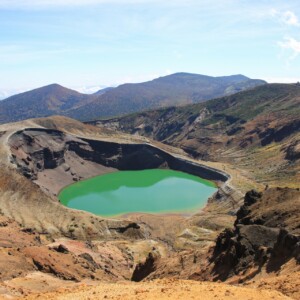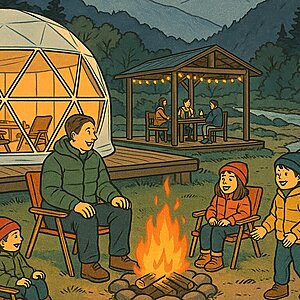
Nanbu Bevelers are the unique residence of the Nanbu Domain, who was well aware of the importance of horses [Iwate Prefecture]
table of contents
- 1 Horses are kept in a main house that is warm all day long, even in the cold and snowy winter months.
- 2 The Nanbu domain was well aware of the importance of horses.
- 3 A farmhouse where military horses are raised with a large curved house.
- 4 A small number of ``Nanbu Magariya'' remain.
- 4.1 The former Sasaki family residence was built in the 1700s. "Iwate Prefectural Museum"
- 4.2 Tono Furusato Village, where six Nanbu Magari houses have been relocated and preserved
- 4.3 The former Kikuchi family residence is an extension of the curved house. "Tono Densoen"
- 4.4 Nambu Magare house is almost the same as before. "Morioka Handmade Village"
``Magari-ya'' is a unique and humane residence built for people to live together with a stable inside the house. In the north of the Kanto region, especially in Iwate Prefecture, during the Edo period ``Nanbu Magariya'' were built.

Horses are kept in a main house that is warm all day long, even in the cold and snowy winter months.
Old Japanese houses with thatched roofs in an L-shaped shape remain in various parts of the Tohoku region. "Magariya" is called "Magariya", and the name may vary slightly depending on the region, such as "Kuya", "Kuya", "Kuya", "Kuya", "Kuya", "Kuya", "Kuya", "Kuya", "Kuya", "Kuya", "Kuya", especially in the Aizu region of Fukushima Prefecture and Iwate Prefecture (Nanbu "Kuya".
many farmhouses were built in the form of curved houses and horses in a stable inside the house
There were many Magariya from Iwate Prefecture to Aomori Prefecture, and although they are all Magariya in the sense of living with horses, the purpose of breeding them was completely different from other areas.
The Nanbu domain was well aware of the importance of horses.
During the Edo period, the Nanbu domain ruled most of Iwate Prefecture and the area from the Shimokita Peninsula in Aomori Prefecture to the area around Hachinohe.

The Nanbu family was a family of the Genji clan that founded the Kamakura Shogunate, and they were initially given territory in the southern part of Kai Province (present-day Nanbu Town, Yamanashi Prefecture) and took the Nanbu surname. After that, Minamoto no Yoritomo (1147-1199) participated in the Battle of Oshu, which destroyed the Oshu Fujiwara clan in Hiraizumi in 1189, and was rewarded for his great achievements. He was assigned the eastern part of the Tohoku region (Nukabugun, the former name of the place).
Originally, was a production area for extremely powerful horses that were useful as a labor force The Nanbu domain thought that the horses could be used for military purposes, so they built a ranch and began breeding horses. At the same time, farmers are also encouraged to raise horses.
The importance of horses was recognized by the Edo Shogunate, and the Edo Shogunate's third shogun, Tokugawa Iemitsu, entrusted two male and female Persian horses (Arab breed) imported from the Netherlands to the Nanbu domain. He orders the improvement of horses. At the time, the Japanese native breeds were powerful but not very fast, so they tried to create the ideal horse by breeding them with the fast Arabian breeds.
Furthermore, there is a record that the 8th Shogun Yoshimune also gifted a Persian horse to ``Bareki Shrine'' in Sannohemachi, Aomori Prefecture (Touma monument).
A farmhouse where military horses are raised with a large curved house.
Farmers originally kept horses for agricultural purposes, so they were accustomed to handling horses. It was not difficult to receive military horses from the clan and raise them.

Magariya was the best way to raise cats to survive the winter cold and live comfortably. It is believed that several military horses were bred in one house, and the magariya was larger and more impressive than those in other regions. This suggests that farmers who raised military horses were highly valued by the clan

A small number of ``Nanbu Magariya'' remain.
Due to the involvement of the Nanbu domain, the ``Nanbu Magari-ya'' in the southern region ended their role with the passage of time and were demolished one after another. The few remaining valuable Nanbu Magari houses include the Former Sasaki Family Residence, which is designated as an important cultural property of the country , as well as Tono Furusato Village, where six houses have been relocated and preserved, and Tono Furusato Village. You can tour places such as Tono Denshoenen and Morioka Handmade Village.
*The Chiba Family Residence (Tono City, Iwate Prefecture), which is a nationally important cultural property and represents the Nambu Magare family, is currently undergoing major renovations and cannot be visited as of April 2022. Completion is scheduled for 2027.
The former Sasaki family residence was built in the 1700s. "Iwate Prefectural Museum"

The ``Old Sasaki Residence'' is a valuable building that still retains its old style, and is estimated to have been built between the end of the Edo period and the beginning of the Meiji period. The one originally located in Iwaizumi Town, Iwate Prefecture was relocated to the Iwate Prefectural Museum in Morioka City and is now open to the public. It is a nationally important cultural property.
Iwate Prefectural Museum <Information>
- Facility name: Iwate Prefectural Museum
- Address: 34 Matsuyashiki, Ueda, Morioka City, Iwate Prefecture
- Phone number: 019-661-2831
- Opening hours: 9:30-16:30 (admission until 16:00)
- Admission fee: 310 yen for adults, 140 yen for students
- Closed: Mondays (or the following weekday if Monday is a public holiday), year-end and New Year holidays, and material sorting period (please inquire)
- URL: Iwate Prefectural Museum homepage
Google Map
Tono Furusato Village, where six Nanbu Magari houses have been relocated and preserved
``Tono Furusato Village'' is a facility that recreates a nostalgic farming village and allows you to experience a farming village.

Inside the village, private houses built from the Edo period to the Meiji period have been relocated, and you can try your hand at rice planting, harvesting, pottery making, dyeing, and other handicrafts.
Six of the buildings are ``Nanbu Magariya'' with thatched roofs, and all of them are quite large and impressive for farms.
Tono Furusato Village<Information>
- Facility name: Natural hometown experience village Tono hometown village
- Address: 5-89-1, Kamitsukebaushi-cho, Tono City, Iwate Prefecture
- Phone number: 0198-64-2300
- Opening hours:
- March to October/9:00 to 17:00 (Reception until 16:00)
- November - February / 9:00 - 16:00 (Reception until 15:00)
- Closed: Winter (December-March)/Wednesdays, New Year holidays April-November/No holidays
- Admission fee: General 550 yen, Elementary, junior high and high school students 330 yen
- URL: Natural hometown experience village Tono hometown village homepage
Google Map
The former Kikuchi family residence is an extension of the curved house. "Tono Densoen"
The ``Old Kikuchi Family Residence'' was built in the mid-1700s, and a curved house was added later to house military horses. It is a nationally important cultural property.

The relocated ``Tono Denshoen'' is a facility where buildings such as the ``Magariya'', ``Watermill'', and ``Tsurube Ido'' have been relocated, and where you can reenact Tono's traditional events and listen to folk tales. You can also try your hand at making folk crafts.
Tono Denshoenen <Information>
- Facility name: Tono Denshoen
- Address: 5-1 Chiwari 6, Tsuchibuchi, Tsuchibuchi, Tono City, Iwate Prefecture
- Phone number: 0198-62-8655
- Opening hours: 9:00-16:00 (admission reception until 15:30)
- Admission fee: 330 yen for adults, 220 yen for elementary, junior high and high school students Closed: Open every day
- URL: Tono Denshoen homepage
Google Map
Nambu Magare house is almost the same as before. "Morioka Handmade Village"

"Morioka Handmade Village" is a complex facility divided into three zones: "Nanbu Magari-ya", "Handmade Workshop", and "Morioka Regional Local Industry Promotion Center Zone". The ``Handmade Workshop'' has about 15 factories, including Nanbu rice crackers, Morioka cold noodles, and Nanbu iron kettles, and you can enjoy tours and hands-on experiences.
``Nanbu Magari-ya'' was built in the late Edo period, and has been relocated and preserved in its original form, including the stables and dirt floor.
Morioka Handmade Village <Information>
- Facility name: Morioka handmade village
- Address: 64-102 Oirino, Morioka City, Iwate Prefecture
- Phone number: 019-689-2201
- Business hours: 8:40-17:00
- Closed: Year-end and New Year holidays
- Admission fee: 100 yen
- URL: Morioka handmade village homepage



![Take a walk through the original Japanese scenery at Michinoku Folk Village, an outdoor museum that houses ancient architecture! [Iwate Prefecture] Michinoku Folk Village's southern territory Date territory boundary mound](https://jp.neft.asia/wp-content/uploads/2024/03/PXL_20240218_063155755-150x150.jpg)
![Maezawa Koya Village, a Japanese original landscape that remains with many traditional "masters" [Minamiaizu Town, Fukushima Prefecture] 1618401_m](https://jp.neft.asia/wp-content/uploads/2022/06/1618401_m-150x150.jpg)

![The specialty of Genbikei, "Flying Dango," is definitely worth a visit! Delicious activities! [Ichinoseki City, Iwate Prefecture] Genbikei bus stop](https://jp.neft.asia/wp-content/uploads/2017/04/IMG_5931-150x150.jpg)
![Bottle Don is the definitive Sanriku souvenir that looks delicious! [Iwate Prefecture] Bottle don (abalone, scallop, salmon roe)](https://jp.neft.asia/wp-content/uploads/2023/06/IMG_5048-150x150.jpg)
![Ryusen-no-no-no-no-no-no-no-no-no-no-no-no-no-no-no-no-no-no-no-no-no-no-no-no-no-no-no-no-no-no-no-no-no-no-no-no-no-no-no-no-no-no-no-no-no-no-no-no-no-no-no-no-no-no-no-no-no-no-no-no-no-no-no-no-no-no-no-no-no-no-no-no-no-no-no-no-no-no-no-no-no-no-no-no-no-no-no-no-no-no-no-no-no-no-no-no-no-no-no-no-no-no-no-no-no-no-no-no-no-no-no-no-no-no-no-no-no-no-no-no-no-no-no-no-no-no-no-no-no-no-no-no-no-no-no-no-no-no-no-no-no-no-no-no-no-no-no-no-no-no-no-no-no-no-no-no-no-no-no-no-no-no-no-no-no-no-no-no-no-no-no-no-no-no-no-no-no-no-no-no-no-no-no-no-no-no-no-no-no-no-no-no-no-no-no-no-no-no-no-no-no-no-no-no-no-no-no-no-no-no-no-no-no-no-no-no-no-no-no-no-no-no-no-no-no-no-no-no-no-no-no-no-no-no-no-no-no-no-no-no-no-no-no-no-no-no-no-no-no-no-no-no-no-no- [Iwate Prefecture] Ryusendo Cave (first underground lake)](https://jp.neft.asia/wp-content/uploads/2023/07/PXL_20230512_052246926.NIGHT_-150x150.jpg)
![[Series ②: The role of the previous nine years and the role of the second three years] The role of the previous nine years is from the truce to the battle again, and the Kokufu army is struggling Taga Castle Ruins](https://jp.neft.asia/wp-content/uploads/2023/11/a0b8b1213124e7a13c7308fa81e053a2-150x150.jpg)
![[Iwate Prefecture] Soft-serve ice cream with sake, miso and wasabi flavor! Why are the soft serve ice cream eaten at roadside stations so delicious? There's also school lunches! Iwate Prefecture Catch](https://jp.neft.asia/wp-content/uploads/2025/06/915fd0ce722ab0f21e74864401170847-150x150.jpg)











